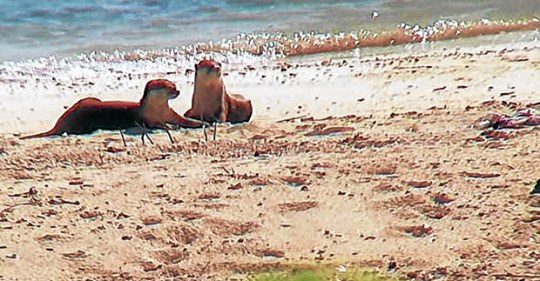
VISITORS FROM THE SEA Residents of Taganak Island in Tawi-Tawi and conservationists vow to protect the smooth-coated otters visiting their community. | Contributed Photo
ZAMBOANGA CITY, Zamboanga del Sur, Philippines—They are known as “anjing laut,” the Malay word for “sea dogs,” in neighboring Sandakan, Sabah, according to Tawi-Tawi residents who occasionally visit that part of Malaysia.
But on Tawi-Tawi’s Taganak Island, where the sea creatures have been seen for the first time toward the end of Ramadan last month, the smooth-coated otters (Lutrogale perspicillata) appeared skittish and would quickly rush back to the sea whenever dogs approached.
The island’s dogs, however, seemed afraid of these visitors from the sea.
New record
Conservationists said the otters seen romping on a beach in Taganak—one of several islands that make up Turtle Islands in Tawi-Tawi—might have come from nearby Borneo Island.“These are a different species of otters from what we have in Palawan … There is also no doubt that these individuals came from Sabah,” Kester Yu, a conservationist of Balete Conservancy and president of the Turtle Conservation Society of the Philippines, said in a recent Facebook Messenger interview.
Located less than 15 nautical miles (27.78 kilometers) away from Sandakan in Sabah, Turtle Islands are the country’s closest cluster of islands along the boundaries with Borneo, where four different species of otters have been known to thrive, Yu said.
Otters recently sighted on Taganak Island make up the second species of otters recorded in the Philippines after the Asian small-clawed otters (Aonyx cinereus) previously seen in Palawan, he said.At least two romps (group of otters) were first seen on the island on May 25, when Muslims celebrated Eid al-Fitr, the end of the fasting month of Ramadan.
“Each romp consisted of two adults and a pup; or at least six individual otters that we know of,” said Yu, who observed that the two romps did not seem to interact with one another.
“This is a new record of the species in the country,” he added.
Daily sight
It was the Taganak police who first found the otters, said Police Maj. Alpaser Haber, acting police chief of Turtle Islands.
Haber said it meant something for locals to see the otters on the day they observed the end of Ramadan. “It greatly helped that the local people believed all the blessings to have come from Allah, including the natural resources and the different animals. It somehow lessened the threat (that the otters were facing),” he said.
After the Eid al-Fitr celebration, the otters became a new daily sight in Taganak. They were often seen playing near the town’s police station.
“They are very much welcome here,” Haber said. “But we also have to ensure that measures are in place so that they will not decimate the harvest of some fisherfolk or accidentally be trapped in the fish cages.”Police are mapping out the sightings and closely monitoring how the sea creatures may interact with fishing communities on the island.
Lyca Sandrea Gonzales Castro of the International Union for Conservation of Nature Otter Specialist Group, confirmed that what the locals saw on the island were otters.
Other than Taganak, there are no reports, so far, of otters seen in any area within the Turtle Islands.
Migration
Yu said otters might have gotten there accidentally.
“But it’s definitely a natural occurrence. Other than torrential rains the night before, we still do not know the complete circumstances how or why they traveled to Turtle Islands. The closest river is approximately 15 nautical miles away,” he said.
“Perhaps because of the recent reduction of sea traffic, it may have been more favorable for them to travel long distances,” he added.
Yu said further studies were still needed to be made to understand the migration of otters from neighboring countries. “There is still so much that we do not know. They seem to be comfortable [in Taganak]. They are technically nonnative, but most likely, they got there through natural causes.”He said waters around Turtle Islands, a protected area, were also considerably cleaner and more pristine than those surrounding the neighboring towns of Sandakan.
‘Great news’
Yu said conservationists would start monitoring the otters’ population in Taganak.He said the smooth-coated otters mainly prey on fish, unlike the Asian small-clawed otters known for eating crabs and crustaceans.
“So far, there also have not been any reports on predation toward turtle hatchlings. Fortunately, marine turtles on Taganak Island do not nest on the parts of the beach where the otters are found, ” Yu said.
He described the otters’ presence as a “welcome sign” and “great news” at this time of the pandemic. “They are not covered by travel restrictions brought about by the COVID-19 pandemic,” Yu said in jest. INQ

